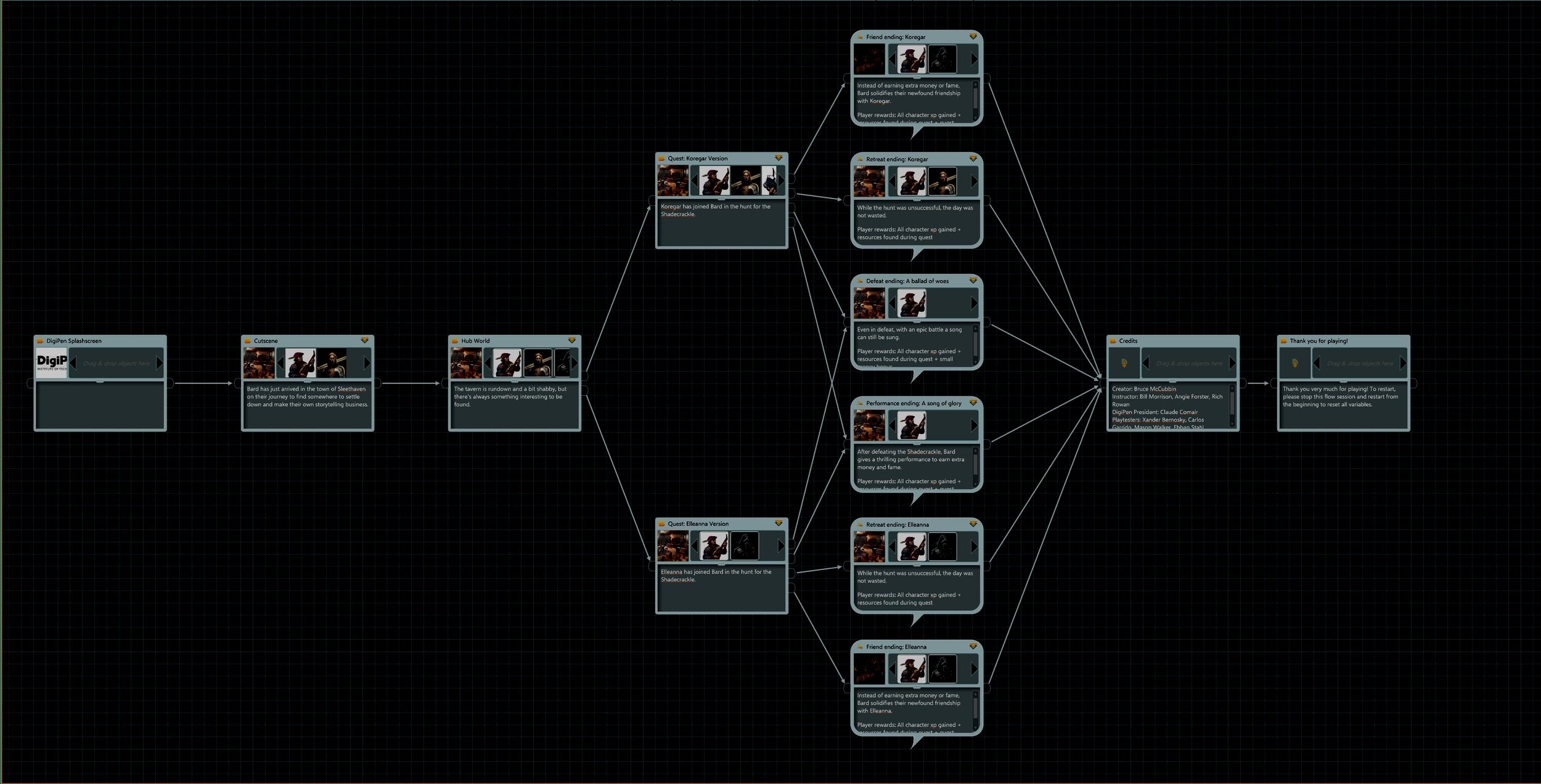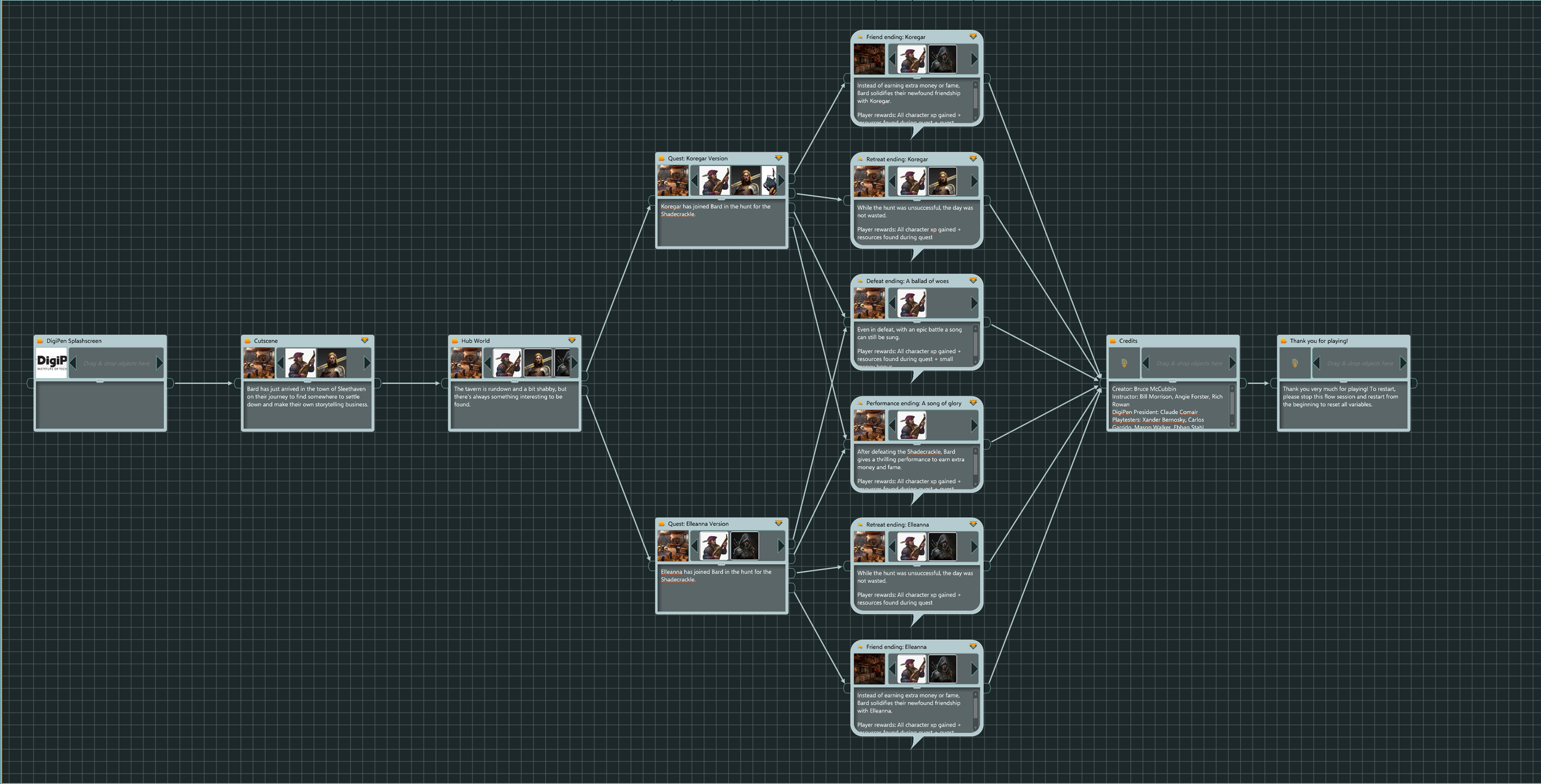
A Bard’s Tale
Example Cutscene, Hub World, and Branching Quest
A Bard’s Tale is a roguelike game where the player takes on the role of a bard looking for somewhere to gain fame and fortune and establish their own storytelling business
Project Spec.
Intro cutscene script
Hub world interactions with three npcs
Branching narrative quest with two companion options
Developed in Articy:Draft
Created over 22 weeks
Solo project
Intro Cutscene
A Bard’s Tale follows a bard as they make a name for themself as a renowned storyteller. The intro custcene shows the beginning of that journey with the bard arriving in a poor town riddled with monster attacks.
The cutscene for this project was initially a standalone script written using proper script formatting that was later adapted to fit the tools within Articy:Draft and the visual novel format A Bard’s Tale evolved into. This proved to be an interesting challenge as transitions between segments of the cutscene needed to be redesigned for the new style. Fades such as the daydream segment were rewritten with more detailed language to make it clear what was happening without the use of cinematography. Other elements such as Koregar’s dialogue were redone to reflect Koregar’s character better.
Hub World
To make A Bard’s Tale feel more complete, I added a hub world between the intro cutscene and the branching quest to allow players to interact with npcs and get to know them and the world better before going into the quest. The hub is separated into three main segments that allow for different interactions. These sections are designed with the intention that they would be expanded upon in a full version of A Bard’s Tale, with the bar as the main place to talk to non-hero npcs, the tables as the location the player can speak with each character they have unlocked, and the quest board as the place the player chooses what job to take next.
Creating the hub world became a much more in depth endeavor than initially anticipated. When I created the conversations with the heroes, I felt they needed enough options to feel like the player had real choice in what they wanted to talk about while also allowing the character’s voice to shine. I also had to make sure each conversation was unique and nobody gave the same information to the player to encourage players to explore all the conversations.
Branching Quest
The main portion of this project is the branching quest, where the player chooses one of the two heroes available to hunt down a monster known as the Shadecrackle. The quest is designed to be integrated into gameplay with various hubs separated by different sections of tracking, fighting, and looting. This helps the quest feel like a part of a full game rather than a visual novel with implied gameplay.
Each choice made in the quest has some kind of significance on the gameplay or character relationships, such as getting to know your companion more or choosing to resolve a conflict peacefully. The outcomes of events are affected by which companion is taken on the quest, which shows how different classes and personalities can have a profound impact on the narrative. The character significance also compliments player choice by allowing players to experiment with different playstyles and finding who they want in their party.
Each version of the quest has four possible endings that give different rewards or penalties. The ending acquired is based on player choices during conversations and encounters and estimations of gameplay areas such as fights. Friendship endings are the hardest to acquire since the player has to make the right choices in conversations in order to unlock them, which gives players something to strive for. Since rewards are different for the friendship and performance endings, players have to choose which rewards they value more.
One element that is not shown in this project is having multiple heroes in a party. Having multiple characters on a quest in a game like A Bard’s Tale is a great chance to show how they interact with each other. This could include conflicts between party members that could add another layer to player choice and branching narrative that would affect the game far beyond the current quest.
Project Takeaways
One of the major things I learned from doing this project is how to combine gameplay with narrative and make it feel natural and good. While the gameplay itself is not fully integrated in to this project, I still show where it happens and why, along with transitions to the narrative elements. These transitions areas are some of the most important part of the game because it’s important not to take players out of the moment.
Another important lesson I learned is how to scope a narrative better. My original plan for this project included much more in-depth endings for the quest, but this proved to be unnecessary. Having the endings be shorter helped cut down on the dev time while allowing for the quest to shine as the main portion of the project. Reshaping how the endings work also helps show that this is a part of a larger game instead of a standalone sequence.

